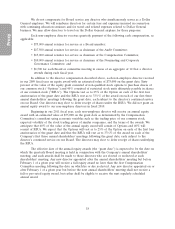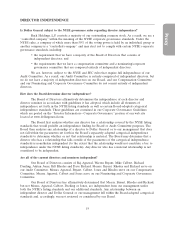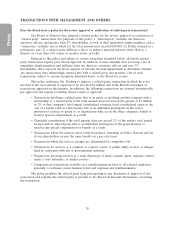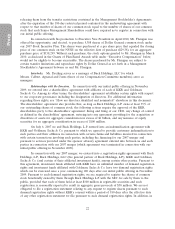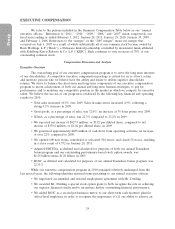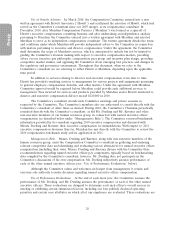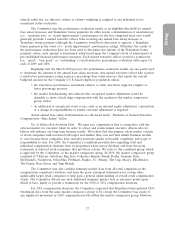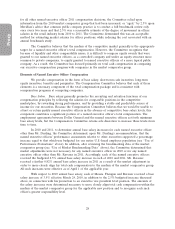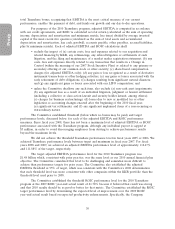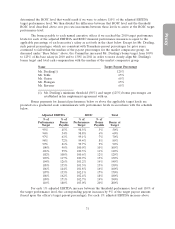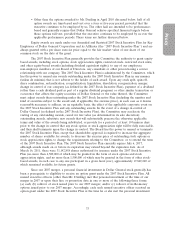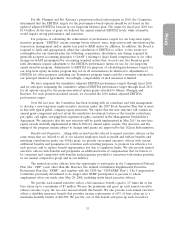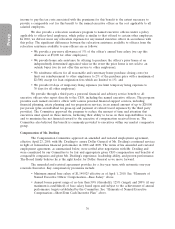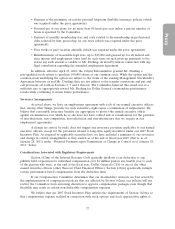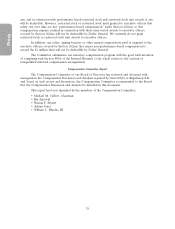Dollar General 2010 Annual Report Download - page 36
Download and view the complete annual report
Please find page 36 of the 2010 Dollar General annual report below. You can navigate through the pages in the report by either clicking on the pages listed below, or by using the keyword search tool below to find specific information within the annual report.
Proxy
for all other named executive officer 2011 compensation decisions, the Committee relied upon
information from the 2010 market comparator group that had been increased, or ‘‘aged,’’ by 2.5% upon
Meridian’s advice that common public company practice is to conduct a full benchmark review only
once every two years and that 2.5% was a reasonable estimate of the degree of movement in officer
salaries in the retail industry from 2010 to 2011. The Committee determined this was an acceptable
method for estimating market salaries for officer positions, while reducing the cost associated with an
annual benchmark study.
The Committee believes that the median of the competitive market generally is the appropriate
target for a named executive officer’s total compensation. However, the Committee recognizes that
because of liquidity and other comparability issues, it is difficult to compare equity awards that were
granted to our named executive officers, as a controlled company and under an equity structure more
common to private companies, to equity granted to named executive officers of a more typical public
company. As a result, the Committee has focused primarily on total cash compensation in comparing
our executive compensation program with companies in the market comparator group.
Elements of Named Executive Officer Compensation
We provide compensation in the form of base salary, short-term cash incentives, long-term
equity incentives, benefits and perquisites. The Compensation Committee believes that each of these
elements is a necessary component of the total compensation package and is consistent with
compensation programs at competing companies.
Base Salary. Base salary generally promotes the recruiting and retention functions of our
compensation principles by reflecting the salaries for comparable positions in the competitive
marketplace, by rewarding strong performance, and by providing a stable and predictable source of
income for our executives. Because the Compensation Committee believes that we would be unable to
attract or retain quality named executive officers in the absence of competitive base salary levels, this
component constitutes a significant portion of a named executive officer’s total compensation. The
employment agreements between Dollar General and the named executive officers set forth minimum
base salary levels, but the Compensation Committee retains sole discretion to increase these levels from
time to time.
In 2010 and 2011, to determine annual base salary increases for each named executive officer
other than Mr. Dreiling, the Committee determined, upon Mr. Dreiling’s recommendation, that the
named executive officers’ performance assessments relative to other executives supported a percentage
increase equal to that which was budgeted for our entire U.S.-based employee population (see ‘‘Use of
Performance Evaluations’’ above). In addition, after reviewing the benchmarking data of the market
comparator group (see ‘‘Use of Market Benchmarking Data’’ above), the Committee determined that
market adjustments were not necessary for any named executive officer in 2010 or for any named
executive officer other than Mr. Ravener in 2011. Accordingly, each of the named executive officers
received the budgeted 2.5% annual base salary increase in each of 2010 and 2011. Mr. Ravener
received a further 0.82% annual base salary increase in 2011 as a result of the market adjustment in
order to more closely align his total cash compensation to the median of the market comparator group.
All such increases were effective as of April 1 of the applicable year.
With respect to 2010 annual base salary, each of Messrs. Flanigan and Ravener received a base
salary increase of 3.5% effective March 24, 2010, in addition to the 2.5% budgeted increase discussed
above, in connection with his promotion to an executive vice president level position. The amounts of
the salary increases were determined necessary to more closely align total cash compensation within the
median of the market comparator group for the applicable new position and to recognize each such
officer’s greater responsibility level.
28


